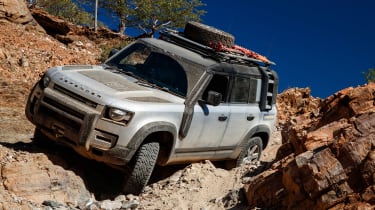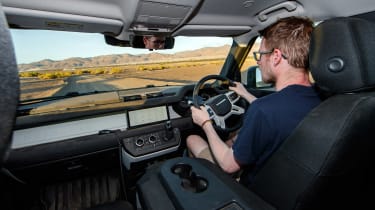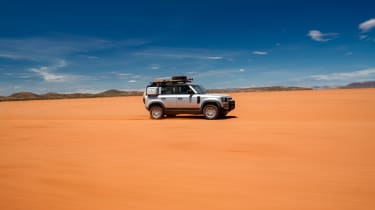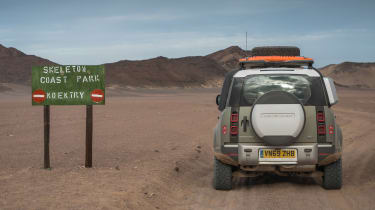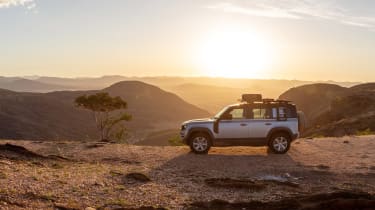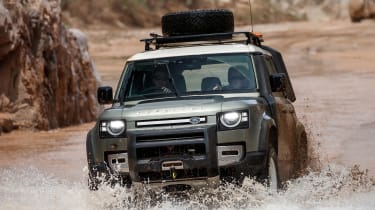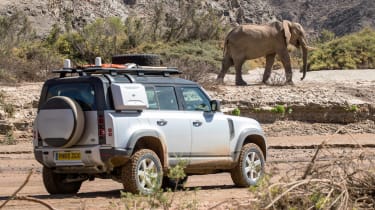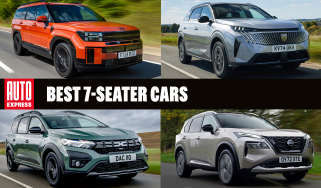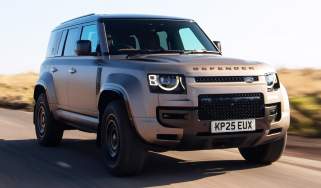Taking the new Land Rover Defender 110 off-road in Namibia
The reborn Land Rover Defender 110 needs serious off-road ability to live up to its name. How better to test its mettle than a three-day African trek?
Storm Dennis has done its best to stop me getting there, but after three flights and an overnight stay in Namibia’s capital city, Windhoek, I touch down in Opuwo, the country’s most northern big settlement, on an ex-military, hard-packed gravel runway to drive the new Land Rover Defender.
With the local Himba tribespeople swarming the air strip to check out the commotion, three new Defenders drop down to the runway to pick us up.
On a motorshow stand the car’s design looks modern and forward-thinking, but in the middle of nowhere, well inside the Tropic of Capricorn, with nothing but sand in sight, the Defender looks like an alien body.
Yet with the test cars kitted out with the optional Adventure Pack and side steps, plus a few other special bits and pieces – including a roof-mounted spare wheel, sand ladders, a front-mounted winch, spades and extra kit – the Defender looks totally at home, too. This is what it was engineered to do, and that is obvious as the convoy rolls out of Opuwo.
Around 7,500 people live in the town, so a few key roads are tarmac, but after 1.8 miles the convoy leader crackles over the radio telling me to wave bye-bye to the black stuff; it’s the last I’ll see of it for three days.
And from the moment the Defender rolls onto the loose gravel road that leads us to my overnight camp it’s perfectly obvious that this car is at home.
It’s arid and the ground is dry, but huge washouts traverse the road, showing evidence of flash flooding just a week before. These aggressive depressions carved by fast-flowing water look innocuous enough but could end my trip just as it’s started by damaging suspension components, a radiator or even the engine, so it’s best to exercise some caution.
But clipping along at 70mph, the Defender shrugs off the loose surface beneath its off-road tyres, providing confidence-inspiring stability, surprising agility and – straightaway – fun. It’s a theme that is destined to become stronger and stronger throughout the journey.
Wiping speed off for washouts is easy given that stability, and the Land Rover will actually hop through all but the worst of the gulleys at a surprising pace. That’s because the 110’s standard adaptive air suspension cushions the blow sweetly and controls the Defender’s hefty 2,248kg bulk.
After around 125 miles – 123.2 of them totally off road – the Defender has acquitted itself well, but my Land Rover Experience guides tell me that day one is just a warm-up and that there’s a lot tougher terrain to face tomorrow.
Day two
They’re right. After what can be no more than 10 miles of treacherous ground itself, dodging ravines and boulders, one of the toughest pieces of off-road driving looms large in the Defender’s bluff, upright windscreen: Van Zyl’s pass.
Now I have to call on the Defender’s Terrain Response technology and switch the system out of Auto and into Rock Crawl. This raises the air suspension for maximum ground clearance and selects low-range mode on the gearbox to crawl glacially over sharp scars that can easily slash even the Defender’s extreme off-road rubber.
It’s Namibia’s toughest road – except it’s not a road, but more of a jagged, rocky route over a mountain that travellers have taken for decades without any development to the path.
The pass itself can’t be much more than five miles long, but it takes hours for the convoy to carefully and safely negotiate its way through. A few punctures halt our progress, but Land Rover’s tech team challenge themselves to replace the wheels and tyres as quickly as possible. By the fifth and sixth punctures, which come at the same time, they have the process off to a tee.
The Defender shrugs this all off, though. It highlights how anyone can tackle ridiculously uncompromising ground with some expert guidance. The car’s four-wheel-drive system just keeps clawing at the surface, while the solid 550Nm of torque in the P400 model that we’ve switched to for day two lugs the car up and out of any situation.
With the air suspension locked out at its maximum height, the ground passing underneath the car’s wheels bumps and jostles the Defender’s new monocoque body around as its big nose points skywards. From the driver’s seat you see nothing but clouds, which is where the ClearSight Ground View technology comes into its own.
Super wide-angle cameras in the door mirrors and the grille project a virtual 180-degree picture onto the Defender’s 10-inch touchscreen, delayed ever so slightly so the image it shows of the ground underneath is synced perfectly to what the wheels are rolling over.
It means you can place a tyre exactly over a sharp ridge – the correct technique to avoid a sidewall-pinching puncture.
It’s a brilliant innovation that makes off-roading even easier, but Land Rover’s All Terrain Progress Control helps too. This low-speed cruise control maintains momentum and maximises traction when you’re off-roading, so I set my speed at a slow walk and the Defender ploughs on.
It feels unflustered, and that’s reinforced coming down the other side of Van Zyl’s pass. With rolled-over, mangled pick-up trucks littering the sheer drops to the side of the track, reminding me how one small movement could spell disaster, the Defender’s hill descent control takes care of speed and braking, so all I have to worry about is steering.
As the terrain starts to level, the scenery changes. Sharp rocks and boulder-strewn hillsides make way for expansive sands as the convoy drops into the Marienfluss valley.
The soft sand forces another change of driving mode, and the Defender flashes through the scorching 40-degree-plus heat as the colours outside the window change from vibrant reds to golden yellows and back again. It’s here that the car’s fun and agility start to really shine through.
The washboard corrugations in the tracks of previous vehicles shake the Defender’s trim (it’s to be expected), but the ride is relatively good. As these tracks disappear and the only way to navigate the vast expanse ahead is by following the dust of the Defender a kilometre in front, at 80mph on the loose surface I guide the car through direction changes between the odd vibrant green tree or shrub. The quick steering highlights that the Defender is actually quite alert for a big, off-road-focused SUV on knobbly tyres.
Not once has the quick steering compromised its solidity and planted feel during the really slow-going off-roading, but it does make the car genuinely fun to drive.
Driving enjoyment doesn’t have to be about high levels of grip and supercar-style acceleration. The Defender proves as much, and anyone who has driven an old Defender will know exactly what I mean by that.
There’s a sense of satisfaction from extracting the best of any car’s abilities, whatever they are. And that’s very much true of the Defender 2.0, whether that’s traversing some tough muddy swamp or rocky outcrop, or smoothing out your inputs on-road to make for a more refined drive.
The Land Rover absolutely delivers, and as our convoy winds its way through the scrubland, weaving through trees and bushes on the last few miles to our second overnight stop, we’re treated to an awe-inspiring sight when a herd of browsing giraffes, split in two, flanks our train from either side. The Defender gets you to places like this, lets you see sights like this, when few others could manage it.
Day three
My final day starts as the previous one ended, with giraffes dominating the view and conversation. As I pull out of our evening’s digs at Elephant Lodge, Puros, heading towards Namibia’s Skeleton Coast, the topography changes again.
Without any wind to whip away the fine dust from the gravel road, we can’t avoid engulfing the car behind. So we have to resort to big separations between cars again, putting 10km between the head and tail of the convoy.
The edges of the road are marked by gentle berms littered with sharp stones, and with the washboard surface on the exit of corners caused by cars digging in for traction under acceleration, the violent rattling of the Defender’s solidly built trim is back. But after nearly three days not so much as one of the beautifully finished Torx bolts that hold the cabin together and give the car its rugged appeal without having an impact on luxury has worked loose.
Access to the Skeleton Coast National Park is extremely closely monitored but we’ve got permission to proceed under the supervision of a warden. We wait at the edge of the Park for our guide, but she never arrives. Time passes and we still don’t hear from her, so with plenty of distance to cover on our final day and time of the essence, we move on without our chaperone but under strict instructions to not deviate from the tracks of the car in front.
Seemingly impenetrable dust clouds and savagely ribbed roads turn to smooth, soft sand cloaking big, aggressive boulders just under the surface, before the landscape evolves into an almost lunar look.
Our average speed really troughs as we have to wind our way through carefully, sticking to the agreed route to not impact wildlife – although there isn’t much of that around on this most open and barren leg of our journey yet.
The ground is relatively easy to cross on this section, with just the odd pocket of deep, soft sand that needs a heavy, committed right foot on the accelerator to power you through the hardest obstacle. But I’ve always got to be aware of solid rock lurking just out of vision over a drop-off or in a depression that could take out something mechanical and critical if I’m a little over-zealous with my speed, just like those washouts on day one.
Every car in the convoy emerges unscathed, save for a few scuffs and scrapes, so we pull up in front of what looks like Pride Rock from The Lion King for a well-earned tea break. We might be in Africa, but these are British cars being driven by Brits, and some things are sacred…
Well refreshed, I jump back into my white steel-wheeled Pangea Green D240 Defender for the last stint. As I tip into the river bed the convoy will navigate on our way to Opuwo, a downpour just a week before my arrival means the sand gets soggy the further we press on. The Defender’s weight starts to push the tyres deeper, squidging through the sun-baked crust into the soupy substance below.
Another change of mode on the Terrain Response system is needed, and I select Low Range for the gearbox once again. In the Mud Ruts setting the system allows some ‘controlled tyre slip’ – wheelspin to me and you – while the gearbox holds onto ratios to keep the revs up.
However, it takes a few attempts at wading through the deepest, sludgiest parts of the river to learn as much.
A few cars get stuck, but that’s thanks to driver error more than anything else. Once we’ve got the cars winched out and calibrated right for the stuff we’ll face ahead, there’s no stopping the convoy. The driving mode and gearbox set-up keeps the Defender literally ploughing on, thrashing its way through the mud and down the river bed at more than 60mph in places.
Where the rocks narrow, the water forms pools because the drainage isn’t so good, so I really have to power through these parts. The wipers frantically try to clear the screen but lose the battle against the torrent of water flooding over the Defender’s squared-off front wings.
Nevertheless every car gets through cleanly. In fact, our only other stop between the final winching exercise and leaving the river bed is to witness a lone bull elephant on the bank who is less than impressed with our interest in his day. After a few minutes he lumbers back off into the bush and we’re back on our way.
It’s a long slog to get back to Opuwo on yet more gravel roads, but the car takes it in its stride, even as we push the pace to get back before sundown. The Defender keeps going. It doesn’t miss a beat.
That’s the overriding theme of the three days. No matter what the conditions, the terrain, the type of driving, or who is behind the wheel, the Defender doesn’t falter. In fact, it’s been better than that. It’s kept me comfortable and cool, it’s entertained me, impressed me, and a brief exploration of its technology has pointed towards it being one of the most advanced Land Rovers to live with yet.
As I finally see some tarmac for the first time in three days I also get a hint that the ride seems good and that the Defender is relatively quiet and refined.
This is undoubtedly a more luxurious car, but it hasn’t lost the personality that made the original Defender what it was. It’s evolved into a thoroughly modern 21st-century vehicle with this all-new iteration, but despite improving the car in pretty much every area, Land Rover has still managed to encapsulate some of that spirit that defined the brand from the start, more than 70 years ago.
That’s a really important point and it’s inextricably linked to the car’s superb off-road performance. If there’s anyone out there who might have been thinking the Defender had gone soft, they’d better think again.
Now read our first drive of the new Land Rover Defender on UK roads right here...
Find a car with the experts





